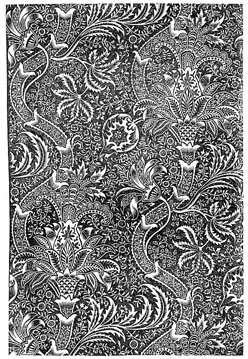MURAL DECORATION - INTRODUCTION; METHODS
(8) Painted Hangings and Wall Papers.
8. Printed Hangings and Wall-Papers.—The printing of various textiles with dye-colours and mordants is probably one of the most ancient of the arts. Pliny (H. N., xxxv.) clearly describes a dyeing process employed by the ancient Egyptians, in which the pattern was probably formed by printing from blocks. Various methods have been used for this work—wood blocks in relief, engraved metal plates, stencil plates, and even hand-painting; frequently two or more of these methods have been employed for the same pattern. The use of printed stuffs is of great antiquity among the Hindus and Chinese, and was certainly practised in western Europe in the 13th century, and perhaps earlier. The South Kensington Museum has 13th-century specemens of block-printed silk made in Sicily, of very beautiful design, Towards the end of the 14th century a great deal of block-printed linen was made in Flanders, and largely imported into England.
Wall-papers did not come into common use in Europe till the 18th century, though they appear to have been used much earlier by the Chinese. A few rare examples exist in England which may be as early as the 16th century; these are imitations, generally in flock, of the fine old Florentine and Genoese cut velvets, and hence the style of the design in no way shows the date of the wall-paper, the same traditional patterns being reproduced for many years with little or no change. Machinery enabling paper to be made in long strips was not invented till the end of the last century, and up to that time wall-papers were printed on small square pieces of hand-made paper, difficult to hang, disfigured by numerous joints, and comparatively costly; on these accounts wall-papers were slow in superseding the older and more magnificent modes of mural decoration, such as wood-painting, tapestry, stamped leather, and painted cloth. A little work by Jackson of Battersea, printed in London in 1744, throws some light on the use of wall-papers at that time. He gives reduced copies of his designs, mostly taken from Italian pictures of antique sculpture during his residence in Venice. Instead of flowing patterns covering the wall, his designs are all pictures—landscapes, architectural scenes, or statues—treated as panels, with plain paper or painting between. They are all printed in oil, with wooden blocks worked with a rolling press, apparently an invention of his own. They are all in the worst possible taste, and yet are offered as great improvements on the taste, and yet are offered as great improvements on the Chinese papers which he says were then in fashion.
The method of printing wall-papers of the better sort is probably the same now that it has always been. Wooden blocks with the design cut in relief, one for each colour, are applied by hand, after being dipped in an elastic cloth sieve charged with wet tempera pigment, great care being taken to lay each block-exactly on the right place, so that the various colours may "register’ or fit together. In order to suit the productions of the paper-mills these blocks are made, in England 21 inches wide, and in France 18 inches wide; the length of the block is limited to what the workman can easily lift with one hand, —2 feet being about the limit, as the blocks are necessarily, and in many cases made heavier by being inlaid with copper, especially the thin outlines, which, if made of wood, would not stand the wear and tear of printing. In "flock" and gold or silver printing the design is first printed in strong size; the flock (finely cut wool of the required colour), or metallic powder is then sprinkled by hand all over the paper ; it adheres only to the wet size, and is easily shaken off the ground or unsized part. If the pattern is required to stand out in some relief this process is repeated several times, and the whole paper then rolled to compress the flock. Cheaper sorts of paper are printed by machinery the design being cut on the surface of wooden rollers, under which the paper passes. The chief drawback to this process is that all the colours are applied rapidly one after the other, without allowing each to dry separately, as is done in hand printing. A some what blurred appearance is the usual result.
Though at first wall-papers were a mere makeshift and feeble imitation of rich textiles, yet, with a good feeling for the harmonies of colour and a regard for the technical necessities of the process, very rich and beautiful effects may be produced at a comparatively small cost if hand printing be adopted. Imitations of stamped leather are now produced with great success, though of inferior durability. Very thick tough paper is used for this, and treated in the same way as the real skins mentioned above. Fig. 6 is a good English example of 18th-century wallpaper printed on squares of stout hand-made paper 22 inches wide. The design is apparently copied from an Indian chintz.
